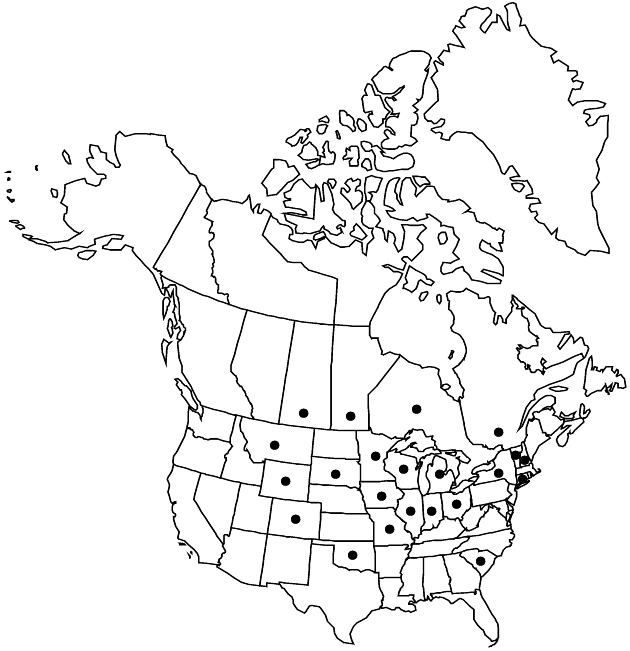Difference between revisions of "Solidago ptarmicoides"
Phytologia 23: 21. 1972.
imported>Volume Importer |
RevisionBot (talk | contribs) m (Bot: Adding category Revised Since Print) |
||
| Line 152: | Line 152: | ||
}}<!-- | }}<!-- | ||
| − | -->[[Category:Treatment]][[Category:Solidago sect. Ptarmicoidei]] | + | --> |
| + | |||
| + | [[Category:Treatment]] | ||
| + | [[Category:Solidago sect. Ptarmicoidei]] | ||
| + | [[Category:Revised Since Print]] | ||
Latest revision as of 14:26, 15 December 2020
Plants 10–40 cm; caudices branching; vascular-bundles and petiole bases marcescent (attached to old stems for more than a season). Stems 1–20+, erect, slender, glabrous proximally, hispid distally. Leaves: basal and proximal cauline persistent, subpetiolate to sessile, blades sometimes 3-nerved, linear to linear-lanceolate, 60–100 × 7–10 mm, stiff, flat, margins entire or subentire, faces glabrous or sparsely hairy; mid to distal cauline sessile, blades linear-oblanceolate to linear, 20–40 × 3–5 mm, reduced distally, margins entire. Heads 1–25 (–50), in corymbiform arrays. Peduncles 29–36.5 mm, strigillose; bracteoles linear. Involucres 5–6 mm. Phyllaries in 4–5 series, usually prominently 1-nerved, linear, strongly unequal, outer acute, inner acute to obtuse, glabrous. Ray-florets 10–20, usually white, rarely pale-yellow (conspicuous); laminae 7–7.3 × 1.4–1.6 mm. Disc-florets 30–36; corollas 3.8–4.1 mm, lobes 0.5–0.7 mm. Cypselae (obconic) 1–1.5 mm (ribbed), glabrous; pappi 3.4–4 mm (apically clavate). 2n = 18.
Phenology: Flowering Jul–Oct.
Habitat: Dry, sandy, usually calcareous soils, cracks in rocks, limestone pavements, rocky outcrops, grassy slopes, prairies
Elevation: 0–1500 m
Distribution

Man., Ont., Que., Sask., Colo., Conn., Ill., Ind., Iowa, Mich., Minn., Mo., Mont., N.H., N.Y., Ohio, Okla., S.C., S.Dak., Vt., Wis., Wyo.
Discussion
L. Brouillet and J. C. Semple (1981) summarized the morphologic, chemical, cytological, and hybridization data on Solidago ptarmicoides and concluded that, except for the white rays, it is a typical member of sect. Ptarmicoidei. The species hybridizes with S. rigida, S. ohioensis, S. riddellii, and perhaps other goldenrods. It is not known to hybridize with any species of aster (regardless of genus); the supposed Aster × Solidago hybrids are the basis of all reports of intergeneric hybrids in the literature. Horticultural hybrids involving S. ptarmicoides and other Solidago species have been treated as S. ×luteus (M. L. Green ex Dress) Brouillet & Semple (×Solidaster luteus M. L. Green ex Dress). Solidago ×bernardii B. Boivin [Oligoneuron ×bernardii (B. Boivin) G. L. Nesom] is the formal name applied to S. ptarmicoides × S. riddellii hybrids; those have cream rays. Solidago ×lutescens (Lindley ex de Candolle) B. Boivin [Diplopappus lutescens Lindley ex de Candolle; D. albus var. lutescens (Lindley ex de Candolle) Hooker ex Torrey & A. Gray; Aster lutescens (Lindley ex de Candolle) Hooker ex Torrey & A. Gray; A. ptarmicoides var. lutescens (Lindley ex de Candolle) A. Gray; Oligoneuron ×lutescens (Lindley ex de Candolle) G. L. Nesom] applies to hybrids between S. ptarmicoides and S. rigida or S. riddellii from the prairies; these also have cream colored rays.
Selected References
None.